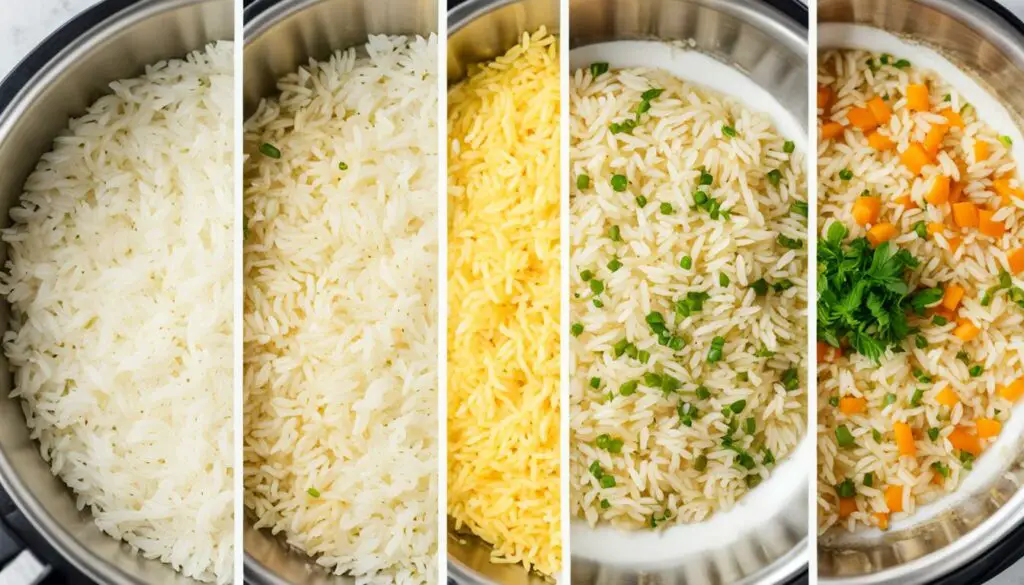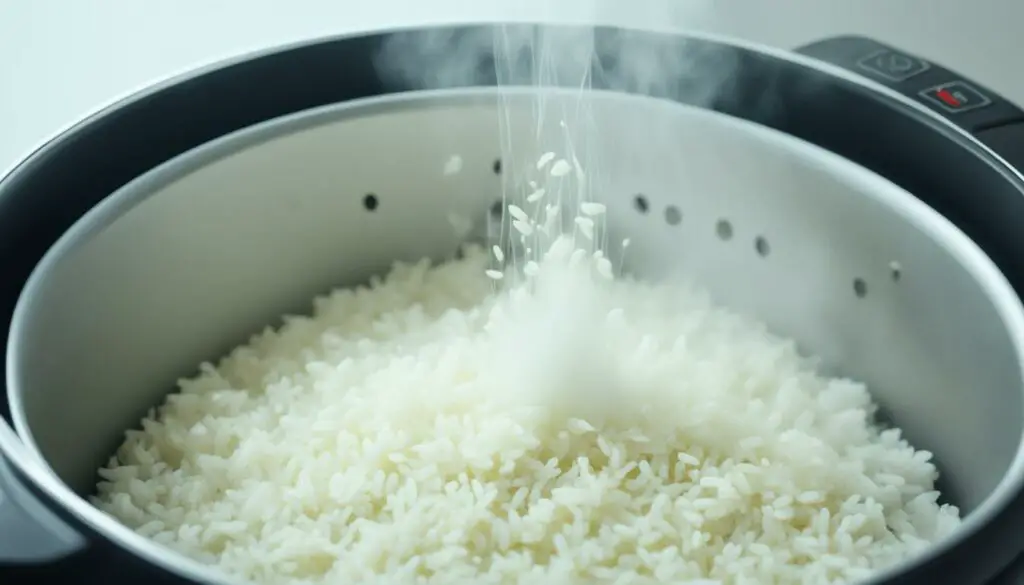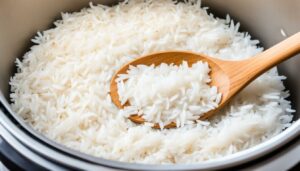Imagine sitting down to a delicious meal, with a main dish that bursts with flavor and a side dish that perfectly complements it. Now, picture that side dish being a fluffy and delicious rice pilaf, cooked to perfection. Sounds incredible, right?
Well, with our easy rice pilaf recipe, you can make this dream a reality right in your own kitchen. No fancy cooking skills required, just a trusty rice cooker and a few simple ingredients. Say goodbye to store-bought rice pilaf and hello to a homemade version that will elevate your meals to a whole new level.
But why choose rice pilaf as a side dish? Well, aside from its delectable taste and fluffy texture, rice pilaf is incredibly versatile. It pairs well with a variety of main dishes, from grilled chicken to savory beef stir-fry. Whether you’re hosting a dinner party or preparing a weeknight meal for your family, rice pilaf is the perfect sidekick.
Now, you might be wondering how to make rice pilaf in a rice cooker. Don’t worry, we’ve got you covered. In the next section, we’ll dive into the key ingredients that make a flavorful rice pilaf, including the choice of rice, the aromatic additions, and the savory liquids that bring it all together.
Table of Contents
The Key Ingredients for a Flavorful Rice Pilaf
When it comes to creating a delicious and aromatic rice pilaf, the choice of ingredients plays a vital role. Each component contributes to the overall flavor and texture, making every bite a delightful experience. In this section, we will explore the key ingredients that make a rice pilaf truly remarkable.
Choosing the Right Rice: Long-Grain vs. Short-Grain
One of the fundamental decisions in preparing rice pilaf is selecting the type of rice to use. Long-grain rice and short-grain rice offer distinct characteristics that can significantly impact the final dish. Long-grain rice, such as Basmati or Jasmine rice, is known for its elongated grains that remain separate and fluffy when cooked. On the other hand, short-grain rice, like Arborio or sushi rice, has a higher starch content, resulting in a stickier and more compact texture when cooked.
The Role of Aromatics: Onions and Garlic
To infuse the rice pilaf with depth of flavor, aromatics like onions and garlic are essential. The sweet and savory notes of caramelized onions complement the nutty taste of the rice, while garlic adds a subtle yet distinct aroma. Sautéing these ingredients in butter or oil before adding the rice creates a flavorful foundation for the pilaf.
Savory Liquids: Vegetable vs. Chicken Broth
Another critical element in rice pilaf is the choice of savory liquid. Vegetable broth and chicken broth are the two popular options. Vegetable broth imparts a mild and earthy flavor, making it a suitable choice for vegetarian or vegan versions of the dish. On the other hand, chicken broth adds a rich and savory taste, enhancing the overall depth of flavors. Both options bring their unique characteristics to the rice pilaf, allowing you to customize the dish based on your preferences.
Step-by-Step Guide: Crafting the Perfect Fluffy Rice Pilaf Recipe
Creating a perfectly fluffy rice pilaf is both an art and a science. With the help of a rice cooker, you can achieve consistent results every time. Follow this step-by-step guide to make a delicious and fluffy rice pilaf that will impress your family and friends.
Step 1: Gather your ingredients.
For this recipe, you will need:
- 2 cups of long-grain rice
- 1 medium onion, finely chopped
- 2 cloves of garlic, minced
- 4 cups of vegetable or chicken broth
- 1 tablespoon of olive oil
- Salt and pepper to taste
Step 2: Prepare your rice cooker.
Before you start cooking, make sure your rice cooker is clean and in good working condition. Follow the manufacturer’s instructions for setting up your rice cooker.
Step 3: Sauté the onions and garlic.
Heat the olive oil in a saucepan over medium heat. Add the chopped onions and minced garlic and sauté until they become translucent and fragrant.
Step 4: Add the rice.
Add the rice to the saucepan and stir well, coating each grain with the onion and garlic mixture. Continue stirring for about 2 minutes to toast the rice slightly.
Step 5: Transfer to the rice cooker.
Once the rice is toasted, transfer it to the rice cooker. Add the vegetable or chicken broth, salt, and pepper. Give it a stir to mix everything together.
Step 6: Cook the rice pilaf.
Cover the rice cooker with the lid and set it to the “Cook” or “White Rice” setting. Let the rice cooker do its magic and cook the rice pilaf until the liquid is absorbed and the rice is fluffy and tender.
Step 7: Fluff the rice.
Once the rice cooker beeps to indicate that the rice pilaf is done, remove the lid and fluff the rice with a fork. This will help separate the grains and give the pilaf its characteristic fluffy texture.
Step 8: Serve and enjoy!
Your perfect fluffy rice pilaf is now ready to be served. It pairs well with a variety of main dishes and can also be enjoyed on its own. Garnish with fresh herbs or sprinkle with toasted nuts for an extra touch of flavor.

Now that you have mastered the art of making a fluffy rice pilaf using a rice cooker, you can confidently prepare this delicious side dish for any occasion. Experiment with different variations and add-ins to create unique flavors that suit your taste. Enjoy the process of cooking and sharing your homemade rice pilaf with friends and family!
Rice Pilaf Pairings: Complementing Your Main Dishes
In addition to being a delicious and versatile side dish on its own, rice pilaf can also be the perfect accompaniment to a wide range of main dishes. Whether you’re serving a juicy steak or a flavorful vegetarian curry, rice pilaf can enhance the overall dining experience by providing complementary flavors and textures.
Matching Flavors with Proteins
When it comes to pairing rice pilaf with proteins, it’s important to consider the flavors and seasonings of both the pilaf and the main dish. For example, if you’re serving a grilled chicken breast with Mediterranean flavors, a lemon and herb-infused rice pilaf would be a fantastic choice. The bright citrus notes and fragrant herbs will complement the grilled chicken beautifully.
On the other hand, if you’re preparing a rich and hearty beef stew, a more robust rice pilaf with hints of garlic and caramelized onions would be a great match. The savory flavors in the pilaf will balance the richness of the beef, creating a well-rounded and satisfying meal.
Vegan and Vegetarian Options
For those following a vegan or vegetarian diet, rice pilaf offers a variety of options to pair with plant-based proteins or vegetable-based main dishes. Consider serving a vibrant vegetable stir-fry alongside a colorful rice pilaf with roasted vegetables and a touch of aromatic spices. The combination of textures and flavors will create a delicious and satisfying meal.
If you’re looking for a heartier option, try serving a flavorful lentil curry with a fragrant rice pilaf infused with warm spices like cumin and coriander. The pilaf will complement the curry, providing a balanced and filling plate.
From Casual Dinners to Special Occasions
One of the great things about rice pilaf is its versatility. Whether you’re hosting a casual dinner with friends or celebrating a special occasion, rice pilaf can be the perfect side dish. For a casual dinner, consider pairing a simple and aromatic rice pilaf with grilled fish or roasted vegetables. The light and flavorful pilaf will complement the freshness of the ingredients.
If you’re preparing a meal for a special occasion, you can elevate your rice pilaf by adding luxury ingredients such as saffron or toasted almonds. This will transform the dish into an elegant and memorable addition to your menu.
Overall, the possibilities are endless when it comes to rice pilaf pairings. With its adaptability and ability to enhance the flavors of main dishes, rice pilaf is truly a versatile and delicious side dish for any occasion.
Why Choose a Rice Cooker for Your Fluffy Rice Pilaf Recipe
When it comes to making the perfect fluffy rice pilaf, a rice cooker can be your secret weapon. Not only does it simplify the cooking process, but it also ensures consistent results every time. Let’s explore the benefits of using a rice cooker for your next rice pilaf creation.
Consistent Results with a Rice Cooker
One of the main advantages of using a rice cooker is the consistent results it delivers. By using preset cooking functions and precise temperature controls, a rice cooker takes the guesswork out of cooking rice pilaf. You can say goodbye to overcooked, undercooked, or sticky rice. With a rice cooker, you can achieve perfectly fluffy rice pilaf with ease.

Advantages of Hands-Off Cooking
Cooking rice pilaf using a rice cooker offers the convenience of hands-off cooking. Once you’ve added all the ingredients to the cooker and pressed the start button, you can step away and attend to other tasks in the kitchen. No need to constantly monitor the cooking process or worry about stirring the rice. With a rice cooker, you can enjoy a hands-off approach and let the appliance do all the work.
Multi-tasking in the Kitchen
A rice cooker is a versatile tool that allows you to multi-task in the kitchen. While your rice pilaf is cooking, you can take advantage of the extra time to prepare other dishes or attend to other culinary endeavors. From chopping vegetables to marinating meats, a rice cooker frees up your time and helps you make the most out of your cooking sessions.
Variations and Add-ins for Your Homemade Rice Pilaf
Take your homemade rice pilaf to the next level by exploring different variations and experimenting with flavorful add-ins. Whether you’re looking to add more depth to the dish or cater to specific taste preferences, these ideas will help you create a rice pilaf that is uniquely yours.
One popular variation of rice pilaf is the use of different grains. Instead of solely using long-grain rice, you can mix in other grains such as quinoa or bulgur for added texture and nutritional value. This not only enhances the visual appeal but also introduces interesting flavor profiles to the dish.
Another way to add flavor to your rice pilaf is by incorporating various herbs and spices. Experiment with herbs like thyme, parsley, or cilantro to infuse the pilaf with fresh and aromatic notes. Spices such as cumin, turmeric, or paprika can also lend a unique and complex flavor profile to your dish.
If you’re looking for a touch of indulgence, consider adding savory add-ins to your rice pilaf. Sautéed mushrooms, caramelized onions, or roasted bell peppers can provide depth and richness to the dish. For a burst of freshness, you can include diced tomatoes, peas, or corn.
“The variations and combinations for rice pilaf are endless, allowing you to customize the dish and cater to different palates. Let your creativity shine and don’t be afraid to try new ingredients!”
– Chef Emily Williams
For those who appreciate a little crunch, consider adding nuts or seeds to your rice pilaf. Toasted almonds, pine nuts, or sesame seeds can provide a delightful texture and complement the flavors of the dish.
Lastly, if you’re looking to incorporate a protein into your rice pilaf, you can add cooked chicken, shrimp, or tofu. This transforms the dish into a complete and satisfying meal.
By exploring these variations and add-ins, you can create a flavored rice pilaf that suits your taste buds and complements your main dishes perfectly.
Conclusion
In conclusion, perfecting the art of rice pilaf in a rice cooker offers numerous advantages. Throughout this article, we have explored the key ingredients, step-by-step guide, pairings, and variations for creating the perfect fluffy rice pilaf. By utilizing a rice cooker, you can achieve consistent results and enjoy hands-off cooking, allowing you to focus on other tasks in the kitchen.
When it comes to storing and reheating rice pilaf, it’s important to handle it properly to maintain its flavor and texture. Store any leftovers in an airtight container in the refrigerator, and when you’re ready to enjoy them, simply reheat the pilaf in the microwave or on the stovetop. Adding a splash of water or broth can help restore moisture.
Lastly, don’t forget to share your delicious rice pilaf creation on social media. By posting photos and sharing your experience, you can inspire others to explore the world of homemade rice pilaf. Who knows, you might even start a trend among your friends and followers!
FAQ
Can I make rice pilaf without a rice cooker?
Yes, you can make rice pilaf without a rice cooker. Simply follow the recipe instructions and cook the rice on the stovetop using a pot or saucepan.
Can I use brown rice instead of white rice for rice pilaf?
Yes, you can use brown rice instead of white rice for a healthier version of rice pilaf. However, note that brown rice may require a longer cooking time and slightly more liquid.
Can I freeze leftover rice pilaf?
Absolutely! To freeze leftover rice pilaf, let it cool completely, transfer it to an airtight container or freezer bag, and store it in the freezer for up to 3 months.
Can I add vegetables to rice pilaf?
Yes, you can add vegetables to rice pilaf to enhance its flavor and nutritional value. Simply sauté your choice of vegetables, such as peas, carrots, or bell peppers, and mix them into the cooked rice pilaf.
Can I use vegetable broth instead of chicken broth for a vegetarian rice pilaf?
Absolutely! Vegetable broth is a great alternative to chicken broth for making a vegetarian rice pilaf. It will still impart a savory flavor to the dish.
Can I use jasmine rice for rice pilaf?
Yes, jasmine rice can be used to make a delicious rice pilaf. It has a fragrant aroma that will add an extra layer of flavor to your pilaf.
Can I add nuts or dried fruits to rice pilaf?
Yes, you can add nuts, such as almonds or pine nuts, and dried fruits, such as cranberries or raisins, to rice pilaf. They will provide a delightful crunch and sweetness to the dish.
Can I make rice pilaf in a pressure cooker?
Yes, you can make rice pilaf in a pressure cooker. Simply follow the instructions provided by the manufacturer for cooking rice in your specific pressure cooker model.
Can I use different spices to flavor my rice pilaf?
Absolutely! Feel free to experiment with different spices, such as cumin, turmeric, or paprika, to add unique flavors to your rice pilaf.






